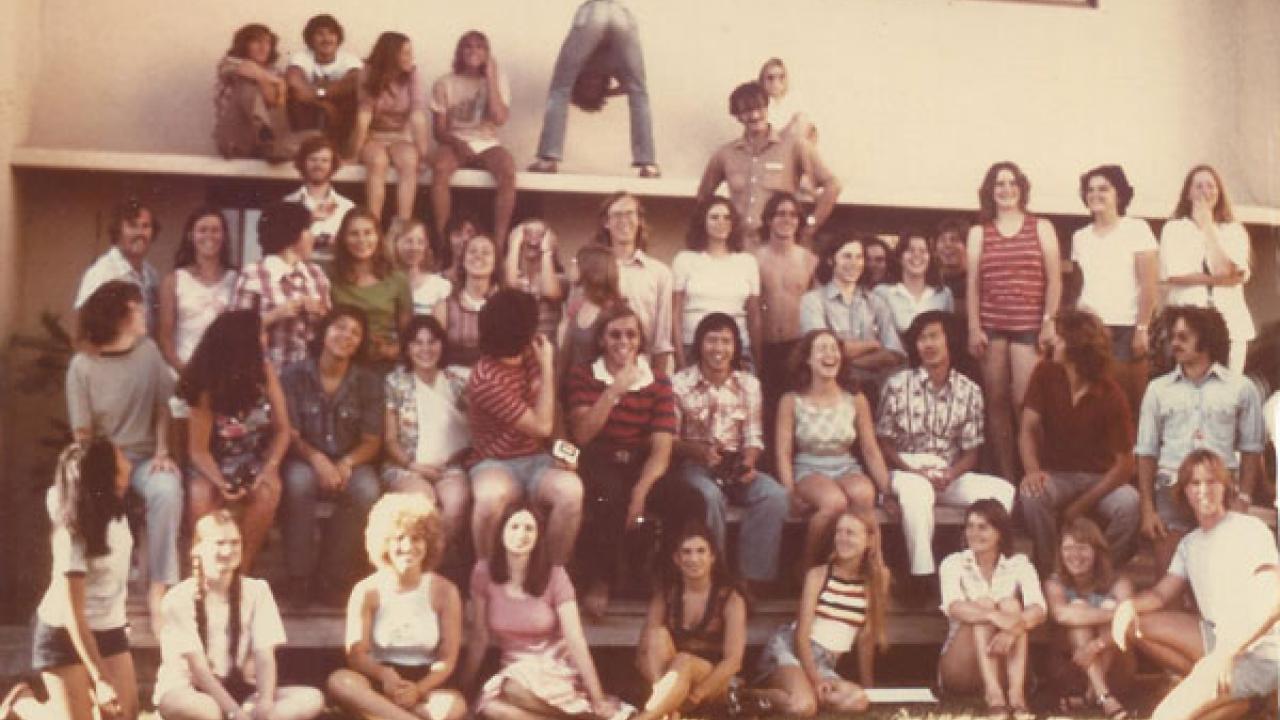
I am Honored
by Carol Harvey, Integrated Studies class of 1974
I was in an honors program 45 years ago and at the time I had no idea. As far as I know, the Integrated Studies program at UC Davis wasn’t an honors program in 1974 when I lived in its B Building hub and took remarkable classes. However, recently I learned Integrated Studies morphed into an honors program, which evolved into yet another honors program. I knew then that is was special and I was lucky to be part of it. I feel even luckier when I look back.
I barely got into Davis. I wrote my essay on the day I needed to mail it in. My mother let me stay home from school to do it. I listed my major as Biological Sciences because “Hey, it’s my favorite subject!” not because I had any interest in a medical career. I was rejected but got in on a well-crafted appeal led by my high school vice-principal. However, when the Integrated Studies brochure showed up some time in the summer of 1974, I was on it. “This sounds good. “ I “applied,” or more accurately, sent back the one page form. I didn’t bother checking with friends who were also headed to Davis. The only hesitation may have been which IS classes to take. They all sounded so interesting and not anything like I expected college classes to be. Tradition and Revolution in Theology was a given but “Tradition and Revolution” in what else? Physics? Art? History?
What was it about the Integrated Studies brochure that made 80 or so high school seniors say, “Yes I want to do that!” Was it random? Was there a common thread? I think we probably shared a love of curiosity, thinking outside the box, compassion, and risk taking.
It was a risk of sorts, to sign up for this funky little gem of a program. I’m so glad I did.
It has been 50 years since Integrated Studies was founded by a few UC Davis professors interested in creating a program that explored the interrelatedness of seemingly unrelated disciplines. The idea that concepts, events, and movements in the arts influence the sciences and vice versa was just beginning to be widely explored in the ‘70s. It was probably even more radical to pair those classes with college freshmen and stick them in the same dorm. I wish I could name all the founders of the program. However, in 1974, Integrated Studies was clearly Ken Greider’s baby. I think Dave Robertson and Art McGuiness were also there from the beginning. Their vision set the tone for my lifelong love of deep conversations and a particular fondness for discussions about change. I still love to talk about the context in which relationships and change happen.
An Integrated Studies reunion for the classes of 1974-1976 will take place Saturday, October 12, 2019.
Email bbuildingreunion1974andmore@gmail.com for more info, and join their Facebook group.
I was able to attend classes that were more like those of grad students. In small, lively seminars focused on meaty topics, I was pushed to wrestle with ideas and not just reconfigure what I had heard in a lecture. At the time, it made me madly uncomfortable. Now I’m grateful. In fact, I wish I could remember more of those brain expanding conversations. I’d love to have a conversation with my 18-year-old self about what ideas would pop up again and again in her life.
I can’t remember a single lecture or fully formed idea of Dave Robertson’s Tradition and Revolution in Theology, but I know it impacted me deeply. The concept of beliefs being time, language and culture bound was-- and is-- profound. The idea that you can only explore just so far beyond the edges of what you already know continues to fascinate me. Your ability to think outside the box to whatever degree you do is limited by imagination, but also by the scaffolding of what you already know and language itself.
I didn’t take Ken Greider’s Tradition and Revolution in Physics until my sophomore year. I knew I had missed out on something the previous year and joined the new crop of IS students. One of our texts was T. S. Kuhn’s The Structure of Scientific Revolution. The concept of paradigm shifts was mind boggling to my 18-year-old self, and still is. Ken playfully taught us that we think one way until we can flick out of our old perceptions and flick into a new way of seeing. Only now do I see the perfect pairing between those two classes.
When I think back on my experience in Integrated Studies, I think how the pleasure, the luck, and the honor is all mine.
In that imaginary conversation between myself-then and myself-now I’d also talk about my Integrated Studies friends and peers. I’d tell that former self that those funny, smart, creative, interesting, compassionate people she happens to live with in a small dorm near a cow barn will still matter to her when she is 63. And she will still think they are funny, smart, creative, interesting, and compassionate.
My young self would be amazed to hear that the much older me would choose to write about her long-ago experiences just for the heck of it. She might be less surprised that her fascination for meaty discussions, infatuation with interrelatedness, and curiosity about change led to a career as a family therapist and adjunct lecturer.
